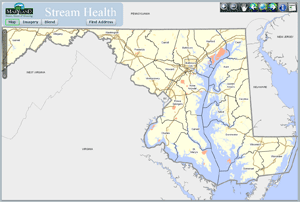Monitoring, data collection, and interpretation
The Resource Assessment Service (RAS) has several tasks related to Trust Fund projects.
- Provide available data and information to Trust Fund managers and applicants for new Trust Fund funding
- Maintain and update information related to Trust Fund project monitoring results
- Coordinate with other monitoring agencies (federal, state, municipal, and private) to share monitoring results
- Maintain the
Maryland StreamHealth website, which allows Maryland Biological Stream Survey (MBSS) data and Maryland Stream Waders volunteer data to be accessed by Trust Fund Managers and applicants
- Use monitoring data to evaluate select BMPs for effectiveness
- Convey monitoring results to the public
When should I monitor my restoration project?
Here is a document that helps answer one of the hardest questions when it comes to collecting data at a restoration project.
Trust Fund Monitoring Protocols
RAS provides protocols to be used when monitoring sites sponsored by the Trust Fund. These methods allow for consistent, accurate monitoring to ensure comparability for BMPs across the State. This allows Trust Fund managers to assess the effectiveness of BMPs and invest accordingly.
The four protocols are:
Resources for Monitoring
If your project plans on monitoring for biology, please refer to the Maryland Biological Stream Survey’s
training page for protocols and training information on collecting these data.
For more information, view these presentations from a 2015 Physical and Nutrient Monitoring Training (in .pdf form) and photos below.
Presentations
-
 Introduction (Luke Roberson, DNR)
Introduction (Luke Roberson, DNR) -
 Water Chemistry (Tom Jones, Versar, Inc.)
Water Chemistry (Tom Jones, Versar, Inc.) -
 Stream Discharge (Heather Quinn, Tim Herb, Andy Watts, Bill Romano, DNR)
Stream Discharge (Heather Quinn, Tim Herb, Andy Watts, Bill Romano, DNR) -
 Geomorphology (Beth Franks, Versar, Inc.)
Geomorphology (Beth Franks, Versar, Inc.) -
 Geomorphology Part II (Sandy Davis, USFWS)
Geomorphology Part II (Sandy Davis, USFWS)
MBSS Data for Trust Fund Managers and Applicants

The Maryland Biological Stream Survey (MBSS) scientists collect chemical, biological, and physical data from sites around the state and Maryland Stream Waders volunteers collect biological data. Maryland Department of Natural Resources maintains the
StreamHealth website as an easy method of viewing these data. It's easy to look up the health of the stream in your backyard, or anywhere else in Maryland. MBSS sites often have photos and a list of species found at each site. If you have questions about data, or would like to request more detailed information, please contact our data manager from our
Data Requests page.
Outcome 1/Trust Fund Stream Restoration Proposals
For stream restoration proposals: Effective FY26 grant cycle (funds available July 1, 2025), CCS will require that stream restoration projects in the areas indicated on
this map provide pre-restoration Maryland Biological Stream Survey (MBSS) benthic macroinvertebrate data in order to be eligible for funding:
- designated cold water streams (MDE Use Classes III and IV);
- existing cold water (identified by the presence of trout or benthic macroinvertebrate cold water obligates Tallaperla and Sweltsa); or,
- high quality (MDE Tier II) stream catchments.
Applicants submitting stream restoration proposals located in the aforementioned areas must provide pre-restoration MBSS benthic macroinvertebrate sampling data that includes Index of Biotic Integrity scores, taxa lists, and MBSS data sheets, and is collected by certified practitioner.
Full requirements available here.
Sharing Results
If you are a monitoring agency investigating Trust Fund project(s), please contact
Robbie Roemer to share your results and receive information from other project managers. Your information will be a valuable resource that will contribute to evaluating BMP effectiveness in Maryland.
For more information about the Chesapeake and Atlantic Coastal Bays Trust Fund, go to the
Department of Natural Resources Chesapeake and Atlantic Coastal Bays Trust Fund Website.